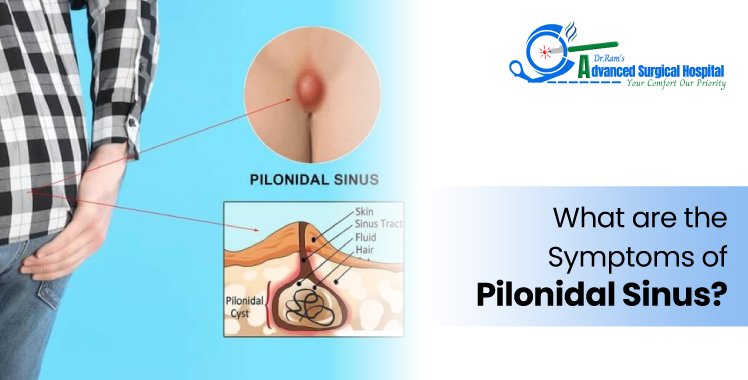What Are the Symptoms of Pilonidal Sinus?

Did you ever have an unusual pain or swelling near your tailbone that just wouldn’t go away? You may have considered it nothing more than a boil or skin infection, but it could be something more serious, such as a Pilonidal Sinus. You can visit Dr. Kamlesh Ram for Pilonidal Sinus treatment in Ahmedabad, he is known for the best results for it. Not often discussed, this condition is much more common than you would think and can become painful if neglected. What are those symptoms of sinus that you should never ignore?
First Things First: What Exactly Is Pilonidal Sinus?
A pilonidal sinus is a small hole or tunnel in the skin, usually located at the top of the buttocks where they divide (the natal cleft). It can fill with fluid, hair, and debris, leading to infection or abscess formation.
This condition mostly affects young men and people who sit for long periods, such as drivers, IT professionals, or students. It may start as something small, but it can turn painful and complicated if left untreated.
Common Symptoms of Sinus (Pilonidal Sinus)
We’ll get to the part you came for, understanding the symptoms.
1. Pain and Sitting Discomfort
One of the first signs of a sinus issue would be pain around the circumference of your tailbone when you’re seated or when you put pressure on the region. It may start as fluctuating pain, but eventually seems more and more intractable. The sensation can spread from a dull ache to sharp, shooting pain, especially if there’s an infection in the mix.
2. Lump/ swelling near the Tailbone.
You may feel a small bump or lump above your buttocks. It's often the first sign that can be seen. Sometimes this lump can become tender to the touch or even warm, if it’s working its way into an abscess.
3. Redness and Skin Irritation
Inflammation is evidence of an active infection. The skin around the lump may appear red, irritated, or slightly raised. If you’re constantly feeling itchy or have a burning sensation in that area, it’s time to get it checked.
4. Pus or Blood Discharge
If the sinus becomes infected, you may notice a foul-smelling discharge oozing from a small opening near the swelling. This discharge can be yellowish (pus) or sometimes mixed with blood. This not only confirms an infection but also means the sinus has become an abscess or is actively draining.
5. Recurrent Infections
One of the more frustrating symptoms of sinus is that it can keep coming back. You may treat it with antibiotics or have it drained, but unless it's surgically removed or properly managed, it may recur. Recurring swelling, pain, and discharge are red flags.
6. Fever or Malaise (in Severe Cases)
If the infection becomes intense, it can lead to fever, fatigue, and a general feeling of being unwell. This means the disease is spreading or has become systemic, and immediate medical attention is needed.
How to Know It’s Not Just a Boil?
A lot of people confuse a pilonidal sinus with a simple boil. But the difference lies in its location and the frequency of recurrence. While a boil can happen anywhere on the body and usually resolves with antibiotics, a pilonidal sinus tends to reappear in the same spot, often needs drainage, and may require minor surgery to remove the sinus tract completely.
Why Ignoring the Symptoms Can Make Things Worse
Many people ignore the initial symptoms of a sinus infection, either out of embarrassment or because the discomfort seems minor. But that can be a risky move. A neglected pilonidal sinus can lead to a chronic condition, the formation of multiple sinus tracts, and more painful surgeries later on.
Early diagnosis and timely treatment can make a huge difference. Whether it’s a simple cleaning, a minor surgical procedure, or laser treatment, the sooner you act, the smoother the recovery.
When Should You See a Doctor?
If you notice any of the following symptoms of sinus:
Pain or swelling near your tailbone that doesn’t go away.
Repeated episodes of pus or blood discharge
Difficulty sitting for long hours due to discomfort
Fever or signs of infection
It’s time to consult a general surgeon or a proctologist. Most treatments today are minimally invasive, and with proper care, recurrence can be prevented.
Final Thoughts
Pilonidal sinus might seem like a minor issue at first glance, but if left untreated, it can quickly become painful and persistent. Knowing the early symptoms of sinus, especially pain, swelling, and discharge near the tailbone, can help you catch it early and treat it before it becomes a bigger problem.
Listen to your body, and don’t be shy about discussing these symptoms of sinus with Dr. Kamlesh Ram. After all, timely care is always better than painful regret.
